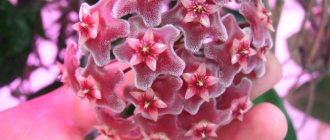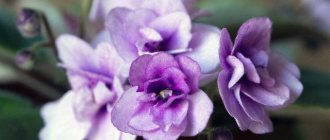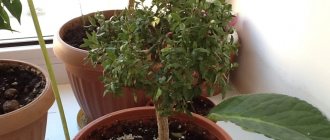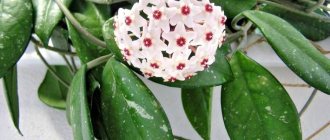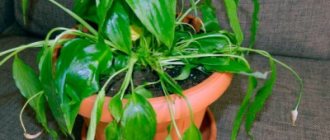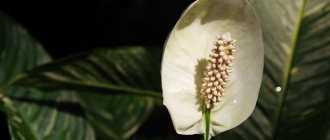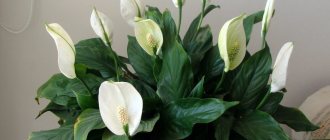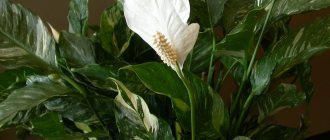"Silver Cupid" or "Silver Cupido" is a popular variety of spathiphyllum. Bright green leaves and chiseled white flowers create a stunning combination. In addition to its beauty, spathiphyllum has a valuable quality - it cleans the air in the room well. In addition, this is an unpretentious variety, easy to care for and blooms for a long time.
Spathiphyllum cupido: home care, reproduction
Spathiphyllum “Cupido” got its name thanks to the Dutch nursery of the same name, which specializes in hybridizing domestic varieties of this plant.
The main feature of the “Cupido” variety is the unusual shape of the petals: they are long, curved, with tips colored green of varying intensities.
Inflorescences appear briefly, for only 1 month in spring, and in small quantities - about a dozen pieces.
Lighting
Spathiphyllum prefers a well-lit place, especially in winter. In summer, you need to make sure that direct sunlight does not fall on them, which causes burns to the leaves. Partial shade is best for them.
For normal development and abundant flowering, the plant needs bright lighting, but without direct sunlight. The best place to keep the flower will be the eastern and western directions of the windows. In the south there is a danger of burns of succulent foliage, and in the northern direction there will be insufficient light.
Temperature
Winter temperatures should not be high: optimally - about 16 ° C - then a dormant period begins, which promotes flowering in summer. The plant can tolerate temperatures not lower than 12-13 °C. In the summer months, spathiphyllum feels comfortable at a temperature of 25-27 °C. Does not like sudden temperature changes and drafts.
Watering
It is necessary to constantly maintain moderate, or possibly high, humidity. This requires abundant watering (there must be good drainage) and frequent spraying of the above-ground parts with water. To establish the optimal humidity level, you can also place the pot in a tray with expanded clay. In winter, water less often.
https://www.youtube.com/watch?v=X3LAkeND1yY
The leaves are cleaned with a damp cloth (the use of lustrating solutions is not recommended). Withered leaves and inflorescences (the spadix enclosed in a spathe) should be removed by cutting them off at the junction with the stem.
Transfer
If it is clear that the roots of the plant have filled the entire volume of the pot, then begin replanting. This operation is carried out in the spring, or even annually, using ordinary universal humus, which is used to fill a pot 1-2 sizes larger than the previous one.
Air humidity
Large leaves need a lot of moisture in the air. If it is too dry, the tips of the leaves begin to dry out.
To maintain the proper level of humidity (70–75%), a humidifier (for example, a tray with wet expanded clay) should be placed next to the plant. You need to spray the flower regularly.
Do not worry about the accumulation of water drops on the leaves; their drooping shape does not allow liquid to linger.
Top dressing
From March to October, the flower is fertilized once every 10 days. In the autumn-winter period, the interval is increased to once a month. Spathiphyllum responds equally well to organic and mineral compositions.
If the grower has the opportunity, then during the growing season you can use an infusion of mullein, diluted in a ratio of 1:20. From mineral complexes, fertilizers for flowering plants without lime content are used, for example, “Azalea”.
The concentration of the solution is no more than 1.5 g/10 l of water.
Reproduction
The easiest way to propagate spathiphyllum is by dividing the bush in the spring. The roots are also carefully separated. Plants obtained as a result of division should be planted in pots or cups filled with loose peat soil with a pH of 5.5-6, with a good drainage layer on the bottom; the temperature is maintained at about 20 °C.
The ideal method of propagating spathiphyllum in home floriculture is by dividing the rhizome. The procedure is carried out simultaneously with the transplant. It is advisable to carry it out in a warm room at a temperature of +20…+23°C.
Process technology:
- An adult plant is divided into several parts, each of which contains part of the root and at least 3 leaves.
- All available sections are treated with crushed activated carbon. Leave for 15–20 minutes.
- The substrate and container are disinfected (calcination, potassium permanganate solution).
- Drainage is placed at the bottom of a small container.
- If you take a large pot, the flower will devote all its energy to growing the root system instead of developing green mass.
The divisions are placed in separate containers. Caring for seedlings is the same as caring for an adult plant. Spathiphyllum does not propagate by leaf cuttings: deprived of roots, they simply rot.
Types of home spathiphyllum with photos and names
Graceful spathiphyllum cupido: detailed description and features of cultivation
In indoor cultivation, the most popular are several types of spathiphyllum out of 50 known in nature:
Spathiphyllum Abundantly blooming (S. floribundum)
A plant with a dense rosette, sometimes consisting of 40 leaves, glossy and dark emerald, 20-25 cm long. It can bloom all year round, the inflorescence is white and yellow.
Spathiphyllum cannifolium (S. cannifolium)
The foliage of this species resembles canna leaf blades and reaches half a meter in height. The cob is light-yellow in color and covered with a delicate white-greenish blanket. With good care, it blooms twice a year: in April-June and at the end of November.
Spathiphyllum Adorable (S. blandum)
It is distinguished by a pale green spathe covering an ear of the same shade, surrounded by large foliage up to 20-35 cm long on petioles reaching 30-40 cm.
Spathiphyllum spoon-shaped (S. cochlearispathum)
A tall species, capable of stretching up to a meter mark. The leaves are large, about 35-40 cm, on petioles 70 cm high. A characteristic feature of the inflorescence is yellowish at the beginning of flowering, and by the end it almost turns black. The blanket is white and has a concave shape similar to a sail.
Spathiphyllum Wallis (S. wallisii)
Perennial from 30 to 60 cm in height with shiny foliage up to 25 cm long. The edges of the leaf blades are wavy. Flowering begins in late spring or early summer, and again in autumn or winter. The cob is light yellow, wrapped in a snow-white blanket, three times larger than the cob.
Chopin is a compact variety no more than 30-35 cm in height with fragrant flowers with an elongated veil with a pointed tip;
Sensation - considered the largest variety for indoor cultivation, reaching 150 cm in height, with foliage almost 80 cm long;
Picasso - a variegated variety with a white-green pattern on the leaves;
Cupido is a Dutch hybrid with an unusual bedspread shape - elongated and tapered towards the top, colored in various shades of green.
Spathiphyllum is very popular in indoor floriculture due to its unpretentiousness and easy care, accessible even to beginners who are learning the basics of handling plants.
Beautiful species loved by gardeners
Spathiphyllum Alana is quite large, about half a meter in length. Widely open leaves of bright green color, located in an upright position, create a rather lush bush and do not bend down, like other species. The plant has a beautifully pointed wide bract. There is a small green streak on the back side.
Chopin (Spathiphyllum Chopin) is a fairly famous variety. We prefer it because it is easy to care for. The flower is ideal for decorating apartments and offices. The plant cleanses the air space of harmful substances, which are usually in excess.
Spathiphyllum Chopin is small, 35-40 cm in height. The leaves of this plant are of a rich green hue, have pointed ends and depressed veins, and the perianth is snow-white and rather elongated, with veins and a green tip. Maintenance is simple and does not require much time and effort.
There is one amazing feature of this plant: during the day the flower smells of a delicate, refined aroma, for which many gardeners love it.
Spathiphyllum Chopin
Let's consider another wonderful plant of the aroid family - Spathiphyllum Sweet Chico. The flower is quite lush and voluminous in appearance, reaching 70-75 cm in length. The flowers are large, cone-shaped. It blooms 2 times a year.
Caring for this plant is not particularly difficult, but there are some important points to consider. It is heat-loving and should not be exposed to cold. In winter, sufficient lighting is required. Since the plant loves moisture, it is worth spraying it periodically.
Every year in the spring it is necessary to replant it into a pot one size larger, but do not overdo it, otherwise the flower will feel uncomfortable in a bulky pot.
Diseases and pests
- Spathiphyllum
The roots rot due to excess moisture in the earthen clod.
- Brown tips on spathiphyllum leaves signal the presence of this problem when it first appears, although it may indicate a dry environment and the need for spraying.
- Pale leaves indicate excess light.
- Drooping foliage always tells the gardener that watering is untimely. True, the plant also often reacts to excess moisture by drooping leaves.
- Leaf blades rot only in conditions of low temperatures and high humidity.
- Perennials grow poorly due to a lack of manganese and iron in the soil mixture or when they are insufficiently absorbed due to cold conditions or reduced air permeability of the soil mixture.
- Leaves curl when the room temperature drops.
- The edges of spathiphyllum leaves turn yellow when the flower is moistened with too hard water.
- Does not bloom if the plant does not have enough lighting or sufficient air humidity. Often the reason for failure to bloom is irregular feeding or a long absence of replanting. It is often possible to initiate flowering by simply moving the flower pot to more favorable placement conditions.
- Droplets on the leaves are called the phenomenon of guttation, when the plant gets rid of excess moisture. It is typical for many aroids and does not pose a problem in care.
Among the pests on spathiphyllum, many insects have been noticed - aphids, scale insects, thrips, mealybugs and whiteflies, but spider mites are especially annoying to the perennial.
Prevention of various problems
- In winter, you should reduce the dose of fertilizing; from its excess, the leaves become covered with brown spots.
- After flowering, the leaves turn yellow - it is necessary to increase watering, add complex fertilizers, and cut out the faded peduncle.
- If there is insufficient air humidity, the leaves may dry out - spraying is required. Place containers of water next to the pots to restore the moisture balance.
- With excessive watering or lack of substrate fertility, the leaves may turn black.
- In a stuffy room, the leaves will become limp and lifeless; regular ventilation of the room is required.
Growing a beautiful Spathiphyllum Cupido is not difficult even for a novice flower lover. The main thing is to follow all the rules of care, replant, fertilize and take care of it on time.
Reproduction of spathiphyllum
The plant is not only unpretentious, but also easy to propagate at home. Usually one of the following methods is used - growing a new bush from cuttings, seeds and propagation by dividing the tuber.
Growing from seeds
The most difficult and time-consuming way to propagate indoor spathiphyllum flowers is by seeds. The easiest way is to buy them in a specialized store than to try to pollinate a flower at home. The germination rate of purchased fresh seeds is 50 percent. The disadvantage of this propagation method is that the new bush will bloom only after 3-4 years. There is no guarantee that the resulting plant will have the characteristics of the mother plant. Because of this, spathiphyllum is practically not grown at home from seeds, but other available methods are used to increase the population.
Propagation by cuttings
Simple and quick cultivation of a new bush from a cutting can be done at any time of the year, but it is better to do this in the spring before the period of active growth begins. A cutting is a bunch of young leaves collected into a rosette. They are first separated from the bush using a sharp knife. Its blade is inserted between the mother plant and the “baby”, cutting through the soil to a depth of 2 cm. At this moment, a characteristic crunch will be heard, after which the shoot is removed from the substrate.
Cuttings with young roots are immediately planted in a pot, and shoots without roots are placed in water with the addition of activated carbon and wait for them to appear. The glass with the plant is covered with a bag and placed in a warm place. The greenhouse is periodically opened to ventilate the contents. When the root system has grown sufficiently, the shoot is planted in a small pot.
Reproduction by flower division
The division method is used when replanting a plant. You can divide a bush with at least three independent leaves. The procedure is carried out in early spring in the following sequence:
- The damp earthen ball along with the roots is removed from the pot and washed under running water.
- Using pruning shears or a sharp knife, divide the tuber so that each plant is left with a leaf rosette with a growing point and its own roots.
- The cut is sprinkled with crushed activated charcoal or charcoal.
- The rhizome is placed on paper to allow the wounds to dry and heal.
- Then the plants are planted in separate pots so that the root collar is on the surface.
- Flowers are watered and sprayed.
Is the plant poisonous?
The flower has poisonous juice , the contact of which with the mucous membrane can cause a severe allergic reaction. People prone to allergies should carefully check the effect of pollen on the body.
When working with spathiphyllum, you should wear gloves.
If, nevertheless, contact with the plant occurs and the following appears:
- rash in the form of red dots (urticaria),
- Strong headache,
- cardiopalmus,
- slow breathing,
- general weakness,
- heavy sweating,
you need to urgently call a doctor. Before the doctor arrives, you can take an antihistamine and activated charcoal, and drink plenty of water. If a child is injured, he must be urgently sent to the hospital , where he will receive qualified assistance.
Pets can also suffer - cats very often try to get the leaves of flowers standing on the windowsill. Symptoms of poisoning will be:
- decreased physical activity;
- slow heartbeat;
- increased and hoarse breathing;
- swelling of the mucous membranes of the throat and esophagus;
- increased salivation.
Your pet needs specialized care from a veterinarian.
3. Varieties and varieties of spathiphyllum:
3.1. Spathiphyllum "Picasso" - Spathiphyllum "Picasso"
A relatively recently bred and rather low-growing, marbled, variegated variety, which is a spathiphyllum up to 50 cm high with basal glossy leaves, painted in a wide variety of combinations of green and white, each leaf of this plant is unique. This species blooms just like ordinary spathiphyllums; it only needs very good lighting to maintain its bright color.
3.2. Spathiphyllum “Sensation” - Spathiphyllum “Sensation”
The tallest and most unpretentious variety with large, hard, glossy, dark green, oblong-lanceolate leaves. The flowers are collected in an inflorescence - a spadix - and are surrounded by a large white blanket. Flowering is very long, but occurs only in good lighting conditions.
3.3. Spathiphyllum "Domino" - Spathiphyllum "Domino"
Relatively compact, broad-leaved, variegated variety. The plants have long and narrow, hard, dark green leaves with long petioles. The leaf blades are glossy, covered with small, white and light green stripes and spots. The flower bedspreads may also have stripes of a green tint.
3.4.Spathiphyllum Chopin - Spathiphyllum “Chopin”
Beautiful large, large-leaved spathiphyllum with abundant and very long flowering. The leaves are on strong long petioles, the leaf blades are oblong, glossy, dark green in color, with pronounced branched veins.
3.5. Spathiphyllum Cupido - Spathiphyllum "Cupido"
Small evergreen perennial plants, reaching a height of 15 - 30 cm. Leaves with slightly corrugated edges, emerald green. Flowering is abundant and long-lasting; the flowers have large, creamy-white spathes, but as they fade they can turn green.
3.6. Spathiphyllum Alana - Spathiphyllum Alana
An elegant, decorative, small-leaved variety with bright green oblong leaves. The flowers' spathes are small, pointed, greenish-white. The plant reaches a height of 30 cm.
3.7.Spathiphyllum Angel Baby - Spathiphyllum “Angel Baby”
A beautiful, variegated, narrow-leaved, perennial spathiphyllum with narrow, thin leaves, painted predominantly in a delicate light green color with thin dark green stripes. The midrib is usually highlighted in a dark shade of green.
3.8.Spathiphyllum profusely flowering - Spathiphyllum floribundum
A compact herbaceous perennial plant up to 30 - 40 cm high. The leaves are oblong - oval, glossy, up to 20 cm long. Small green, yellow or orange flowers are collected in a cylindrical inflorescence - a spadix and are surrounded by a large spathe up to 20 cm long, white or green.
3.9. Spathiphyllum Mauna Loa
A spectacular variety with narrowly lanceolate, glossy, dark green leaves and tall peduncles rising above the foliage. At the tops of the flower stalks there are cylindrical inflorescences with small cream or yellow flowers, surrounded by a wide white or greenish spathe with a green stripe on the outer surface.
3.10. Spathiphyllum cannifolium
A beautiful broad-leaved variety. The plants have large, broadly oval, dark green leaves on long, slightly curved petioles. These bushes look very impressive during the flowering period - when they throw out vertical tall peduncles with single, large, white or slightly greenish spathes.
3.11. Spoon-shaped spathiphyllum - Spathiphyllum cochlearispathum
Giant spathiphyllum, which is an evergreen herbaceous perennial plant up to 1 m high. With good care, it can reach a height of 1.8 m. The leaves are glossy, green, have an elliptical or lanceolate shape, up to 65 cm long with a petiole. Large white spathes can appear throughout the year and remain attractive for up to 30 days each.
3.12. Lovely or pleasant spathiphyllum - Spathiphyllum blandum
Plants with oblong, elliptical leaves. The edges of the sheet plates are often corrugated. During the flowering period, it decorates itself with small, oblong, green or white blankets. Inflorescence - spadix consists of numerous green, yellow or cream flowers.
You might also be interested in:
Chlorophytum
Calathea
Dracaena
Anthurium
Home care
Spathiphyllum Wallis is cultivated only as a houseplant. When growing, mineral fertilizers must be used. In spring and summer from the end of March to the end of September, once every 10 days, when watering highly developed specimens, diluted liquid fertilizer is added to the water (to feed weak plants, fertilizer is taken in a lower concentration). During the rest of the year, regardless of size, plants are fed once a month. Spathiphyllum is ideal for hydroponics.
After purchasing a plant, you need to leave it in its original container for 2 weeks to give it the opportunity to get used to the change in environment. A new microclimate, container, new soil when transplanting a flower is stressful for it. It is advisable to ask the seller about the conditions under which Cupido is kept in the store and change them gradually.
Lighting
Spathiphyllum prefers a well-lit place, especially in winter. In summer, you need to make sure that direct sunlight does not fall on them, which causes burns to the leaves. Partial shade is best for them.
For normal development and abundant flowering, the plant needs bright lighting, but without direct sunlight. The best place to keep the flower will be the eastern and western directions of the windows. In the south there is a danger of burns of succulent foliage, and in the northern direction there will be insufficient light.
Temperature
Winter temperatures should not be high: optimally - about 16 ° C - then a dormant period begins, which promotes flowering in summer. The plant can tolerate temperatures not lower than 12-13 °C. In the summer months, spathiphyllum feels comfortable at a temperature of 25-27 °C. Does not like sudden temperature changes and drafts.
Watering
It is necessary to constantly maintain moderate, or possibly high, humidity. This requires abundant watering (there must be good drainage) and frequent spraying of the above-ground parts with water. To establish the optimal humidity level, you can also place the pot in a tray with expanded clay. In winter, water less often.
Transfer
If it is clear that the roots of the plant have filled the entire volume of the pot, then begin replanting. This operation is carried out in the spring, or even annually, using ordinary universal humus, which is used to fill a pot 1-2 sizes larger than the previous one.
Air humidity
Large leaves need a lot of moisture in the air. If it is too dry, the tips of the leaves begin to dry out. To maintain the proper level of humidity (70–75%), a humidifier (for example, a tray with wet expanded clay) should be placed next to the plant. You need to spray the flower regularly. Do not worry about the accumulation of water drops on the leaves; their drooping shape does not allow liquid to linger.
Top dressing
From March to October, the flower is fertilized once every 10 days. In the autumn-winter period, the interval is increased to once a month. Spathiphyllum responds equally well to organic and mineral compositions. If the grower has the opportunity, then during the growing season you can use an infusion of mullein, diluted in a ratio of 1:20. From mineral complexes, fertilizers for flowering plants without lime content are used, for example, “Azalea”. The concentration of the solution is no more than 1.5 g/10 l of water.
Trimming
The only type of pruning that is performed on spathiphyllum is a sanitary procedure. Remove dried or diseased leaves, and be sure to remove faded flower stalks. The remaining flower stalks weaken the bush, drawing off the lion's share of moisture and nutrients.
Transfer
After waiting a period of 2 weeks after purchase, it is advisable to replant the plant. At home, it is possible to create a more nutritious mixture for a flower than the one in which it was exported. Standard replanting is carried out annually in the spring, before flowering. In adult specimens, the need for the procedure is signaled by roots peeking out of the soil.
For the nutrient soil mixture, the following components are used (in the ratio 2:2:0.5:0.5:1):
- turf soil;
- leaf soil;
- humus;
- peat;
- coarse sand.
The pot can be made of any material, but must have a hole for water drainage. Its size should be several centimeters larger than the previous container.
Transplant technology:
- Before the process, the flower needs to be watered: this will make it easier for the soil to move away from the walls of the pot.
- Given the fragile root system, the flower is extracted by transshipment.
- 2-3 cm of drainage is placed at the bottom of the new container, and a mound of earth is poured on top up to half the container.
- The cleaned plant is placed on a mound of soil and the roots are straightened.
- Add soil evenly along the edges and compact it.
- The procedure is completed by watering and spraying the foliage.
Flower care at home
Spathiphyllum Wallis can be planted in two ways, seedlings and seeds. They are thermophilic, for a comfortable existence they need:
- Temperature from 18 to 24*C, and maintain humidity.
- The plant is a light-loving plant, so it is advisable to place flower pots on the sunny side, but direct sunlight is detrimental to the leaves. They cause burns. The place should be bright enough, without direct sunlight. In a shaded place, as well as in direct sun, the leaves of the plant become pale.
- It is necessary to water with soft, settled water, at room temperature. In summer daily, or once every two to three days, in winter once a week. You need to monitor the soil moisture. The plant likes spraying. If the plant does not have enough water, the edges of the leaf blade begin to turn black and brown spots appear on the leaves. If watering is excessive, the roots rot, this is the most common disease in spathiphyllums.
- Feeding with complex fertilizers is required, once every two weeks. Before flowering, it is necessary to give more phosphorus-potassium fertilizers.
- It is necessary to regularly trim dried leaves and dry flower stalks.
- Plants must be replanted into a pot 3-4 centimeters larger than the previous one. The size of the pot can be easily checked by the length of the roots. The pot should be a couple of centimeters larger than the root.
- During the period when the flower has bloomed, there is no need to feed it. All that remains is abundant watering. It sometimes happens that flowers do not appear for a very long time. This happens due to: an excess of nitrogen fertilizers, too low a temperature, a large pot (until the roots fill the pot, the plant will not bloom).
In order for the plant to bloom, it is necessary to reduce the temperature, if it is not lower than 18*C, to 10*C, and reduce watering for about a month. After such stress, spathiphyllum will bloom.
The main flower pests are:
- Spider mites that leave behind webs can be washed with soap and water if using chemicals does not help.
- Scale insects, a sucking pest that leaves transparent spots, are difficult to see, can be washed with soapy water, but it is better to treat them with chemicals.
- Aphids, clearly visible to the naked eye, are controlled using chemicals.
By following the rules of plant care and always checking for pests, you can create the most comfortable conditions under which the plant will delight you with its beautiful appearance and constant flowering.
What to do if it doesn't bloom?
If all the necessary conditions are met: temperature, humidity and lighting, and the flower does not bloom, you need to create a stressful situation for the plant .
- Reduce the air temperature to +14-16ºС for about 3 weeks.
- Reduce watering.
- Then return to normal conditions, flower stalks will definitely appear.
If a miracle does not happen, you need to look for errors in care: there may be an excess of nitrogen, too low a temperature or lack of moisture.
You need to check the soil moisture at a depth of 5 centimeters.
Description of Spathiphyllum cupido
Spathiphyllum Cupido has the following description:
- The plant is a perennial and belongs to the Araceae family.
- It lives in the tropics, near the shores of water bodies.
- In total there are about 40 species of Spathiphyllum.
- It grows up to half a meter in height.
- The petioles are powerful and long.
- During flowering, up to 10 inflorescences appear on each stem, which bloom simultaneously with others.
- The bush is wide, painted white.
- The core can be silver - Silver Cupido.
As you know, the variety was bred only in the 20th century. The breeder was the German scientist Wallis. However, hybrids are not intended for cultivation in open ground; they can only be kept at home, both in private houses and in city apartments.
Signs and superstitions
They say that if you grow it next to anthurium - “male happiness”, then harmony and mutual understanding will reign in the house. It’s even better to plant them in the same pot, however, many gardeners are skeptical about this sign - plants have significantly different care and maintenance conditions.
One of the most important superstitions associated with the flower indicates the attraction of love and the onset of a long-awaited pregnancy. And the expected event will happen as soon as the spathiphyllum bud blooms.
If the flower dries up, then happiness leaves the family. The plant does not tolerate scandals and quarrels indoors, and immediately drops its lifeless leaves. Whether these signs are true or not is up to each gardener to decide for himself.
Favorable growing conditions
Spathiphyllum is an unassuming houseplant. If you find a suitable place in the room from the very beginning, you will enjoy bright green leaves and long-lasting flowering for a long time.
Temperature
Houseplants native to the tropics do not tolerate cold. The temperature range for heat-loving green room inhabitants is from 18 to 28°C. Spathiphyllum is not recommended to be placed on an open balcony or terrace. The plant can hardly tolerate sudden changes in conditions and temperature changes. Optimal conditions are temperature from 19 to 25°C, constant location.
During the flowering period, the air temperature should be from 21 to 24°C. After flowering, spathiphyllum needs rest. This is not a full dormant period, since the leaves of the plant remain alive, green, and juicy. The favorable temperature during this period is 16–18°C. Spathiphyllum can be stimulated to bloom abundantly in the spring if, from October to February–March, the pot with the plant is placed on a window in a cool room or on a northern windowsill.
Light
The “Silver Cupid” variety requires diffused lighting and does well on north-facing windows. However, with a lack of light, the leaves lose their silvery spots and stripes and become uniformly green. Also, you should not expect spathiphyllum to bloom abundantly in poor lighting.
Green plants are turned from time to time to avoid one-sided bending of the leaves towards the light source. "Silver Cupido" can be rotated and moved to another place only after flowering. It is better not to touch until the flowers appear.
If the pot is located on a south, east or west window, then it requires shading at midday from direct sunlight. The ideal place for a houseplant is a window with a western or eastern orientation. Spathiphyllum, which is located at a distance of 2 m from the window or in the back of the room, does not bloom, the leaves stretch out.
Humidity and watering
A sufficient amount of water is one of the main rules for caring for spathiphyllum. Watering should be regular but moderate. At high air temperatures, the plant requires more moisture. If the soil surface dries out during the day, water daily. In cool weather, watering 1-2 times a week is sufficient.
Spathiphyllum leaves are regularly sprayed with soft water at room temperature. You can give the plant a shower by washing off the accumulated dust with a stream from a spray bottle. The leaves evaporate excess water. This process sometimes occurs so intensely that drops appear at the tips of the leaves.
Feeding
Fertilizers are applied in the spring and throughout the flowering period. The plant requires feeding once every 2 weeks. Use standard fertilizer mixtures for indoor flowers. The amount of powder or granules indicated on the package is dissolved in warm water. Fertilizing is carried out only after watering the plant.
Fertilizers containing phosphorus and potassium stimulate flowering. Nitrogen fertilizing helps to increase leaf size. The rapid growth of spathiphyllum is stimulated by liquid feeding with a solution of urea.
Typically, complex fertilizers with basic nutrients and microelements and organic additives are sold. Just 1–2 g of nutrient mixture is dissolved in 1 liter of water. In autumn and winter, the plant is not fed.
Bloom
When and how?
Spathiphyllum Cupido blooms in April - May. With proper care, flowering is long lasting. 2 - 3 flowers bloom at the same time, flowering lasts a week. Then a few more flowers bloom. Over the entire period, up to 8–10 buds ripen.
Features of care during this period
After flowering, the inflorescence becomes pale green. Before and during flowering, it is not recommended to replant the flower; flowering and growth may be slow.
The planting and propagation procedure is recommended to be carried out in mid-June, after the flowering of Spathiphyllum Cupido. During flowering, the air temperature is desirable up to 18°C.
What to do if buds do not appear?
- If Spathiphyllum Cupido does not bloom, and the inflorescences have become pale, it means that it lacks moisture and needs to be watered more. The soil should always be moist, but not soggy or swampy.
- If the pot is constantly in the shade, the inflorescences may not form; you should move the flower to a brighter place.
- It is possible that the pot is too large or, conversely, the bush has grown too much and the pot has become too small for the root system; the flower will need to be replanted.
Subvarieties and their photos
Compacta
Spathiphyllum Compacta differs from other subspecies in the uniform color of its leaves. The central longitudinal vein is not distinguished by the lighter tone of the bright green leaf. The leaves are large, wide, oblong, shiny, medium dense, veined.
Flowering is abundant. In total, up to 10 inflorescences are formed, 3 flowers bloom simultaneously. The inflorescence resembles a spikelet in shape and is soft yellow in color. The flower itself is large, creamy white, decoratively folded, with a pointed end.
Variegated
This rare variety of indoor spathiphyllums is called Charming. The height of the flower is 40 - 60 cm. The leaves are large, wide, light green and have a light longitudinal stripe - a vein in the center of the leaf. It has a special aroma that appears in the early morning hours.
Domino
Also classified as variegated spathiphyllum is the Domino variety - on the dark green background of the leaf, spots and streaks are randomly located across the entire surface of the leaf plate, which gives the flower a variegated decorative appearance.
Picasso
The Picasso variety is distinguished by green leaves with a scattering of large white spots. The flower itself has the shape of a sail, is soft white, the spadix is light yellow.
Read about other varieties of this exotic: Alana and Sweet, Sensation and Chopin, the well-known Wallis spathiphyllum and miniature Strauss, as well as the most popular white varieties.
Reviews
Olga:
“Spathiphyllum is interesting to me because it looks beautiful in the room and does not require much attention. I would like to have different varieties to compare and get several flowering plants.”
Vadim:
“My wife takes care of indoor flowers and introduces me to them. I noticed the unusual color of the leaves. I was told it was Spathiphyllum 'Silver Cupido'. An interesting flower that decorates the room.”
Elena:
“I like many varieties of spathiphyllum, but I prefer plants with variegated leaves. They say that this is a variegated color due to a mutation. I like these “mutants”!”
Video about the best varieties of Spathiphyllum:
How to plant?
The spathiphyllum plant can be planted in two ways:
- Seedlings separated from an adult plant.
- By seeds - this method is used quite rarely due to poor seed germination.
Seedlings
To plant a seedling, you need to choose the right pot.
The pot should be 3-4 centimeters longer than the length of the rhizome.
You cannot take a pot that is too large, because flowering will not occur until the rhizome fills the entire volume of the pot. A pot that is too small can cause the plant to lack nutrients and moisture, which again will cause a lack of flowering.
Step-by-step landing instructions:
- Prepare a pot of the required size.
- Prepare nutritious soil - you can buy it in the store, or you can make it yourself by combining sheet soil, peat, river sand, charcoal and turf soil in equal proportions.
- Water the plant from which the seedlings need to be separated well and leave for a while.
- Then carefully shake the earthen lump out of the pot. A separate seedling consists of three leaves coming out of one rosette and having part of a root.
- Carefully separate the seedlings.
- Place perlite in the bottom of the pot. Fill the soil halfway, mark the seedling and, holding it, cover it with soil.
Seeds
Planting a plant with seeds is not a labor-intensive process, but it requires knowledge of several points. To sow seeds, you need to prepare a container or tray with walls up to 4 centimeters high.
- Pour the soil into a container (it is better to calcine it first), moisten it and sow the seeds.
- Cover the container with glass and maintain the temperature at +23-24ºС.
- It is necessary to monitor the soil moisture, be sure to ventilate so that there is no stagnation and mold fungi do not appear.
- After the seedlings appear, we continue watering and airing until they grow to 3 centimeters.
- We transplant the seedlings into small cups.
- When the seedlings reach 6 centimeters, we transplant them into larger cups.
- After three months, we transplant the seedlings into pots and place them in a permanent place.
- The first feeding of the plant is carried out after two weeks.
